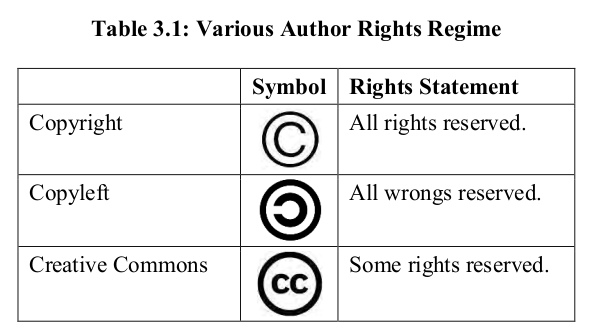3.2 Intellectual Property Rights
Creative and innovative minds of human beings are the main force behind the technological changes for societal needs and comforts. Intellects and ingenious marvels are churning out in innovative solutions to societal problems. In scientific research, researchers deal with many real life problems as well as hypothetical or theoretical problems. The results of research are reported in research literature including journal articles, conference papers, book chapters, monographs, dissertations and research reports. In scientific and technological areas, research results often lead to scientific discovery or invention of new machines, formulae, designs and processes. Thus, scientific research turns into intellectual activities or intellectual exercises undertaken by a broad spectrum of researchers, who later become the knowledge creators, innovators, and finally legitimate holders of intellectual property rights.
WIPO (2008) defines “Intellectual property, very broadly, means the legal rights which result from intellectual activity in the industrial, scientific, literary and artistic fields. Countries have laws to protect intellectual property for two main reasons. One is to give statutory expression to the moral and economic rights of creators in their creations and the rights of the public in access to those creations. The second is to promote, as a deliberate act of Government policy, creativity and the dissemination and application of its results and to encourage fair trading which would contribute to economic and social development.”
There are many forms of intellectual properties for defending rights of knowledge creators, inventors, or authors. Most prominent ones are Patent, Copyright, Trademarks, Industrial Designs and Integrated Circuits (IC), and Geographical Indications (GI).
WIPO (2008) defines ‘Patent’ – a major instrument for protecting intellectual property as, “a document, issued, upon application, by a government office (or a regional office acting for several countries), which describes an invention and creates a legal situation in which the patented invention can normally only be exploited (manufactured, used, sold, imported) with the authorization of the owner of the patent.” The patents are vehicle of protection of intellectual property rights emanated from scientific projects or scientific discoveries. A new product or process or technique derived from a scientific research work, which has certain applications for the betterment of human life, is patentable and inventors can claim it as their intellectual property by registering it with patenting authorities by following certain legal procedures.
WIPO (2008) defines ‘Copyright’ as “a legal term used to describe the rights that creators have over their literary and artistic works. Works covered by copyright range from books, music, paintings, sculpture and films, to computer programs, databases, advertisements, maps and technical drawings.” The copyright is a primary instrument for protecting intellectual properties of scientific and researchers’ communities, as they communicate research findings through publishing papers in scholarly journals, conferences, monographs, theses and other research literature. The Patent is another tool for protecting intellectual property, although prudently used by scientific communities. The Copyright law is country specific and it varies country to country. The author, who is solely responsible for knowledge creation and authoring scholarly works, is the principal owner of copyright. However, many commercial publishers insist transfer of copyright from the creators to the publishers for getting research papers published in their publishing channels such as scholarly journals, monographs, books, conference proceedings, and case studies. While transferring copyright of a scholarly work to a publisher, an author actually transfers a bundle of exclusive rights such as reproduction, reuse, distribution, public performance, translation, public display, and modification of the original work. Most of the author’s exclusive rights get curtailed. The SPARC (2006) highlights some of the rights an author should retain while publishing with for-profit publishers. Text Box 3.1 makes you understand your rights as an author. The SPARC (2006) has developed a model Addendum to Publication Agreement for retaining some author’s rights while an author is signing the Copyright Transfer Agreement (CTA) or Licence to Publish (LTP). While commercial or for-profit publishers have intensified commodification of scholarly works published by them, there are instances of researchers’ communities adopting alternative pathways so that authors and users of scholarly literature retain some of the exclusive rights for fair use and continuation of the knowledge creation process. Table 3.1 shows various author rights regime. Copyright is the conventional method of protecting intellectual properties of authors and creators. Copyleft is a liberal method of protecting author’s rights, while relaxing some rights for fair use and reuse of published literature. Creative Commons is another liberal form of protecting author’s rights, which is most accepted in open access publishing environment.

